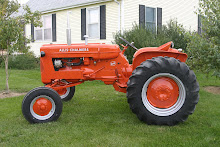We were raised with baling
wire. I know that sounds as if I had a 7th sibling made of wire but
it is close to being true. The wire was an integral part of our everyday farm
life.
In the 1970’s the wire
began its exodus as most of the hay balers went to using twine. Before that,
all of our alfalfa, brome and straw bales were held together with wire. The
wire allowed some of the straw bales to be packed so tight that they would nearly
explode with the mere nicking of the wire. A four foot straw bale could end up bursting
to ten feet long as we cut the wire.
We used bales of straw for
bedding the pigs in the barn and we also fed the feeder cattle with wire tied
hay bales. We used bales in the barn one or two at a time. That meant that we
would have 2 or 4 wires in our hand after bedding the sows. We would then begin
to fold the wires in half enough times so that the result was about a foot long
and then toss the wrapped strands into a pile in a vacant stall. Out in the
feedlot we would sometimes feed 40 bales at a time that meant we had a pair of
pliers in our right hand and a growing supply of wires in our left. When the
load in our left hand got so big that we couldn’t carry it, we’d stop, fold it
in half, wrap a wire around it and then take it to our outdoor pile near the
end of the row of bales.
Those two piles of baling
wire then became the supply that kept the rest of the farm running.
Wire had an almost
unlimited number of uses. One use was to wire the hog panels in the barn. Right
here let me interject that hog panels were to be double wired and tightened
clockwise. If we did otherwise and my Dad had to unwire the panel in the dark
to fence lock in a sow that was ready to farrow, we heard about it. “Who
wrapped this wire the wrong way?” We always thought we were too young to have
to do chores so we’d reply, “You need people working our here who are old
enough to tell time and know which way a clock runs.”
We used the supply of
baling wire for fencing repairs, emergency cotter pins, and our hitch pins
always were wired in. (Clockwise I might add.) I don’t believe that we had a
tractor, harrow, disc, combine, corn picker, truck, seeder, drill any other
piece of equipment that didn’t have several pieces of wire wrapped or twisted
around it.
We could fix the exhaust
system on the old jeep or the Studebaker without going to town. Dad would
simply hand us his pliers and tell us to go get a piece of baling wire.
We’d run to the mountain
of wire that was so large that it wouldn’t have fit in the box of a pick-up and
cut off a length of wire that ended up being about 2 inches two short. We’d get
back to Dad, he’d try the wire and ask “Are we getting short on wire?” “Now go
back and bring enough wire to go all the way around this.”
Almost every temporary fix
on the farm was accomplished with the aid of baling wire. Even if it ended up
being a forever fix. My Dad once fixed the metal frame on a chair from our
daily dining room set with baling wire. That was the day Dad found out that
baling wire wasn’t coming into the house.
Other times the wire
became a curse when someone would run into a pile of used wire with a shovel
type cultivator. A pair of side cutters
and 1 hour will usually be enough to correct that mistake. Single strands of
baling wire laid carelessly about were always the scourge of our lawnmowers.
We still have horses on
the farm but I’m not sure where the used baler twine pile is kept. I do however
know exactly where to find a piece of twine if I need one.
There’s probably one wrapped
around one of the three spindles on my lawnmower deck right now.

